Do you want to continue the conversation?
Join LERRN for our upcoming webinar:
LERRN’s Analysis of Refuge and RSQ: Reflections on Knowledge Production, Access, and Representation
Authors: Kathryn Hampton (University of London), Rachel McNally (Carleton University), Michael Joel Nabugere (University of London) and Nadeea Rahim (Carleton University).[1]
Who publishes in Refugee Survey Quarterly and where do they live? How global is the content? Building on LERRN’s previous analysis of the Journal of Refugee Studies, a team of researchers from Carleton University (LERRN) and the University of London (RECAP) examine these questions in a new analysis of all the journal articles published in RSQ from 2010-2019. The analysis raises important questions to consider for the journal and for the forced migration research community as a whole, around representation of Global South voices and the dynamics of knowledge production.
This article constitute an output of the RECAP Project, and has been supported by UK Research and Innovation as part of the Global Challenges Research Fund, grant number ES/P010873/1 as well as the Local Engagement Refugee Research Network (LERRN), a partnership funded by the Social Sciences and Humanities Research Council of Canada.
This blog post was also published by the Refugee Law Initiative Blog on Refugee Law and Forced Migration.
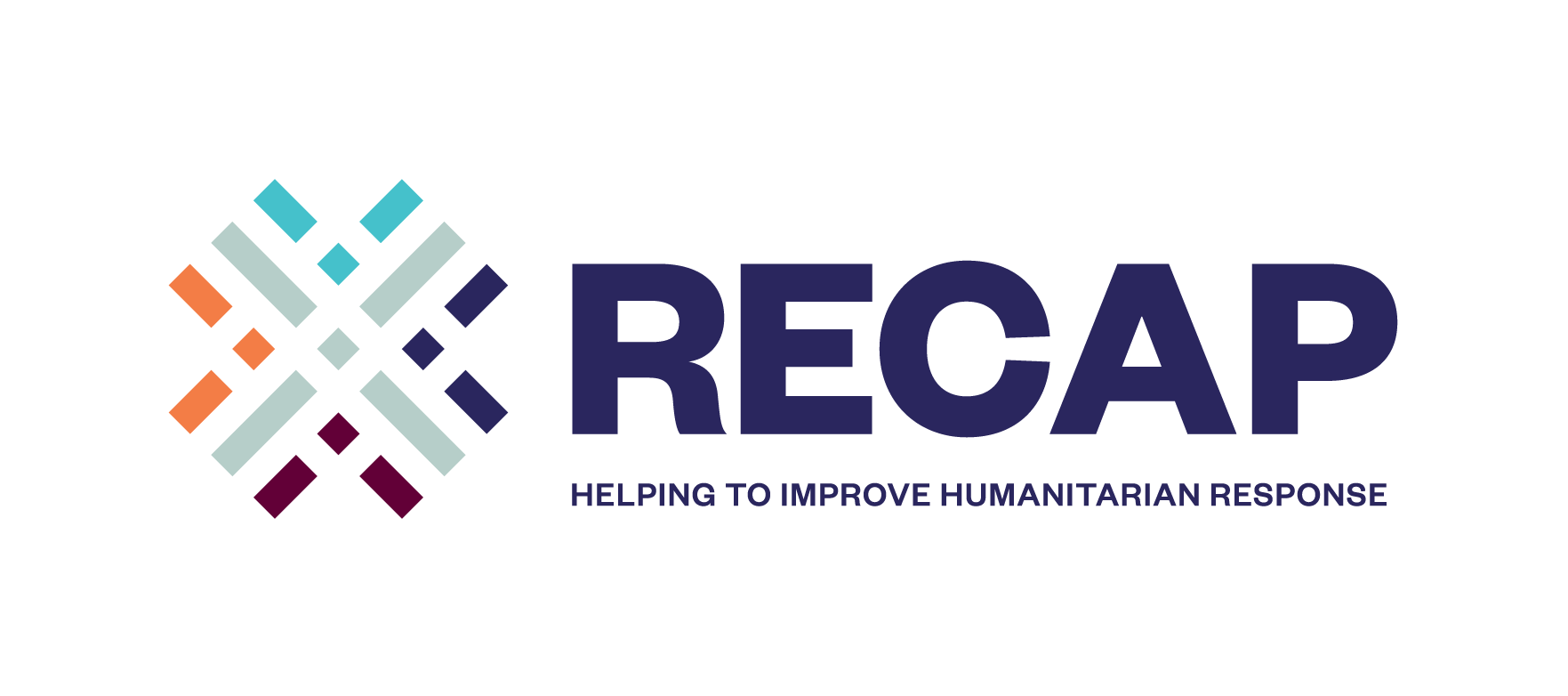

Introduction
This article aims at contributing to the debate on the politics of knowledge production in the forced migration discourse and it does so through an analysis of the Refugee Survey Quarterly (RSQ) journal as a point of departure. For one to contribute to recognised academic literature on forced migration, it is commonly necessary to be published in a widely read journal, such as the RSQ. Representation of different voices in these journals, therefore, matters in terms of representation of different voices in the academic discourse on forced migration overall. All knowledge can be used for multiple purposes,[2] and the political economy of knowledge production has a bearing on the direction of the academic discourse on forced migration.
With 85% of the world’s 26 million refugees and 3.6 million Venezuelans displaced abroad currently hosted in the Global South and 73% hosted in neighbouring countries to their countries of origin, this article analyses the global coverage of articles published by the RSQ between 2010 and 2019 considering their geographic focus, themes and authorship. All the refugee and displaced persons population figures in this article come from UNHCR’s 2019 Global Trends report and reflect the numbers of forcibly displaced persons at the end of 2019.[3] Within the time period covered by the analysis, the number of forcibly displaced people has nearly doubled: from 41.1 million at the end of 2010 to 79.5 million at the end of 2019.
Although author nationality data was not available, the analysis we present considers the geographical distribution of authors by looking at their institutions of affiliation. Using the United Nations Statistics Division (UNSD) Classification of countries (developed or otherwise),[4] we analyse Global North and Global South participation through categorising the articles based on the authors’ institutional affiliations and the countries where these institutions are located. This approach presents an opportunity to analyse which articles we consider to have emerged from the Global North and the Global South. We then consider the content and themes of the published articles, as well as collaborations and partnerships through co-authorships. We conclude the article with questions to consider for the journal and the forced migration research community more broadly.
Global South and Global North
For the purpose of this study, the Global North refers to countries classified as “developed” and Global South refers to countries classified as “developing” by UNSD. There is a possibility of authors being nationals of Global South countries but working in the Global North. Similarly, with technological improvements, for example the improvement in internet access globally, authors might be affiliated to institutions but operating in other areas. For this reason, taking the institution of affiliation does not determine author nationality or exact location. These issues present a limitation in the methodology.
The analysis, however, shows that knowledge generation on forced displacement has been monopolised by institutions in the Global North. An analysis of 210 articles published by the RSQ from 2010 to 2019 indicated that the authors of 89% (184) of the articles published were affiliated to Global North institutions. Only 7% (15) of 210 articles published by the RSQ featured at least one co-author affiliated to Global South institutions while 4% (11) articles were solely authored by scholars affiliated to Global South institutions.
27% (57) of articles published in the period of research focused specifically on forced displacement in the Global South. 44% (92) of RSQ published articles in the period of analysis were focused on issues affecting forced migrants globally or in one or more of the Global South regions. An important question for discussion brought to mind by the findings is whether the academic discourse generated considers issues most pertinent to the majority of the forcibly displaced population. A conclusion on this point, however, is beyond the limits of this particular paper.
These figures are indicative of the broader imbalance in knowledge generation between Global North and South visible in academic journals[5], with authors writing from the Global South having less representation overall in the RSQ. Meanwhile the Global North hosts only 15% of forced migrants yet generates the vast majority of knowledge on this topic.
Authors by country
Authors are from a total of 39 countries, where 59% (23) are based in the global North and 41% (16) are based in the Global South. The United Kingdom leads with 53 articles, 85% (45) of which are single-authored and 15% (8) are co-authored. The UK has the highest number of single-authored articles compared to other countries in the Global North. For comparison, the US is the second leading country with a total of 34 articles, 62% (21) of which are single-authored and 38% (13) are co-authored. As an outlier in the global North, Norway has more co-authored articles (5) than single authored articles (3). Most authors based in the Global South are included in co-authored articles, with the exception of authors based in UAE, Iraq, and Fiji who each contributed single-authored articles.
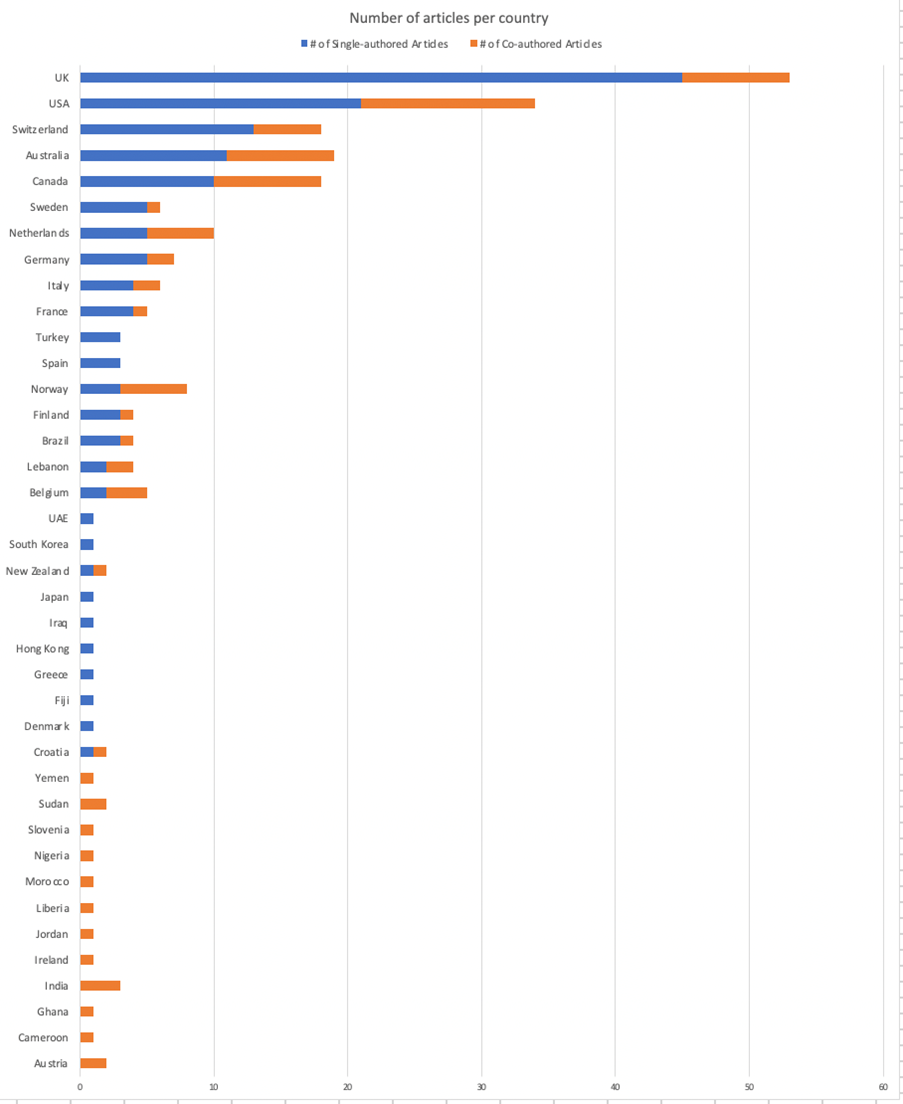
A per capita analysis was also conducted to compare the countries’ population size and the number of articles produced. The per capita calculation was based on the number of articles produced per 10 million people. Co-authored articles were counted by assigning the article to each country involved. This calculation would allow us to see if countries with a larger population (e.g. India) would produce more articles than countries with smaller populations (e.g Norway). The assumption is that countries with larger populations would produce more articles. This is referring to the general population size of a country provided by the United Nations, Department of Economic and Social Affairs, in 2019[6].
The top five countries leading in per capita are: Switzerland, Norway, Fiji, the UK, and Australia. Switzerland leads in per capita with 21 articles per 10 million people while India and Nigeria represent the lowest values with 0. There is a general divide between the Global North and South, where the Global North leads in per capita. This points to the opposite of the per capita assumption as smaller populated countries of the Global North produce more articles compared to the larger populated countries of the Global South. However, there are two outliers in the Global South as part of the top 10 in per capita. For example, Fiji is the third in per capita due to their small population of 890 000 with 1 article.
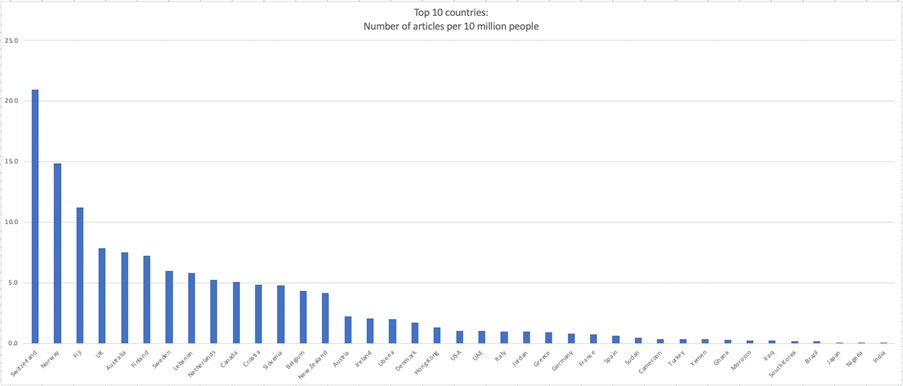
In terms of per capita and authors by country, the UK leads in the number of articles but is third in per capita (7.8 articles/10 million people) due to the population size. The USA places second in number of articles, but places much lower in per capita (1 article/10 million people) at 20th place due to its large population size. Other than Fiji, Lebanon is an outlier in per capita at 8th place, but is 17th for number of articles (4) 2 of which are co-authored. Lebanon is an outlier and has a rather small population in comparison to other countries in the Global South. With their population at 6 856 000 it produced 4 articles giving the value of 5.8 for per capita. However, it is important to consider that 20% of Lebanon’s population are refugees (1 395 000 refugees/6 856 000 total population). Details about the per capita for refugee populations in countries are discussed later on.
Content and themes
This section classifies articles based on different categories of displaced persons, according to the categories included in UNHCR’s population of concern: refugees, internally displaced persons (IDPs), asylum seekers and stateless persons. It also adds an “other” category for groups of migrants who fall outside of UNHCR’s population of concern, such as migrant workers. This section also examines the geographic focus of articles, coding them with at least one country or broader region, or alternatively, a designation that the article is about an international topic without a regional focus or country case study. Given that refugees and other displaced people are hosted largely by certain countries and in the Global South, the geographic focus of the articles was compared to the percentage of refugees and the percentage of displaced persons (all categories included in UNHCR’s population of concern) currently hosted in each country or region. Certain specific countries were counted separately from their broader regions because they currently host a large refugee population (Turkey, Germany) or because of a large number of affiliated authors (UK, the United States, Canada and Australia).
The journal retains a strong focus on refugees and asylum seekers, as the journal’s name would suggest, but it also includes articles on other populations. The majority, 79% (166) of articles look at refugees, asylum seekers or both. Another 7% (15) look at IDPs, including 4 articles from a 2010 special issue on “New Challenges of Migration in Africa,” while 3% (7) articles were about stateless persons, including 6 articles about stateless Palestinian refugees. 20% (41) of articles look at “other” groups of migrants – a heterogeneous group that includes people displaced for environmental reasons, migrant workers, people in immigration detention, and people who have been trafficked, as well as articles about mixed migration – categories that often overlap with asylum-seeking.
RSQ has a wide geographic focus, with articles that examine case studies in every region of the world. Most articles, 80% (168), have a regional focus (including country-based case studies or regional case studies such as European asylum law), while the other 20% (42) look at international issues with no specific country case study, such as international refugee law. The graph below shows the geographic focus of the articles with a regional or country-specific focus.
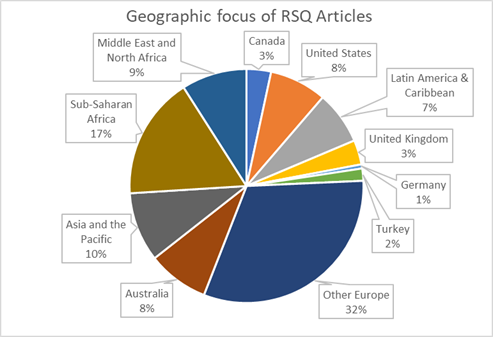
Although the UK is the country with the highest number of affiliated authors, with 25% (53) of articles including a UK-based author, a much smaller percentage of articles 4% (6) of articles with a regional focus study refugees and other migrants in the UK. That means that most authors based in the UK are not writing about the UK, and are more commonly writing about international issues with no regional focus 9% (18), the European Union and mainland Europe 5% (11), or a variety of other countries and regions. Without nationality information, it is difficult to tell if some of the UK-based authors are scholars from other countries who have taken positions at UK universities, while continuing to write about their countries of origin. Compared to articles about refugees and other groups in the UK, there are more than double the number of articles focusing on refugees in Australia 9% (15) and the United States 8% (14).
Although the journal has a global focus, comparing the percentage of articles about each region to the percentages of displaced persons currently hosted by each region, Global North countries are overrepresented, while Global South countries are underrepresented. Although the distribution of refugees around the world has changed within the last decade, with major new displacement situations like Syria and Venezuela, it has remained consistent that the majority of refugees seek refuge in countries neighbouring their countries of origin, which are primarily countries in the Global South. The graph below compares the geographic focus of the articles to the percentage of refugees and the percentage of UNHCR’s population of concern (displaced persons) hosted by each country or region.
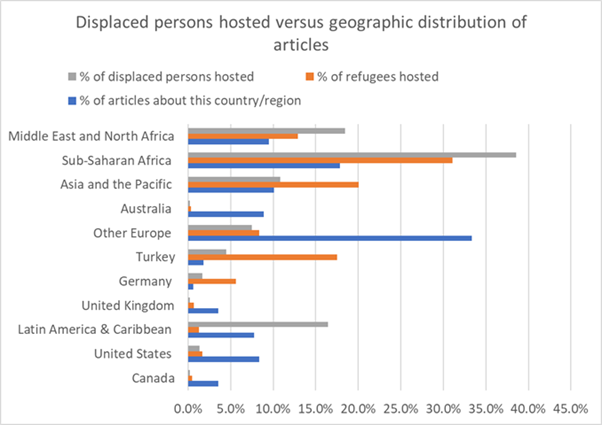
More than one third of the articles, 38% (63) with a regional focus study refugees and other migrants in Europe, yet this region only hosts 15% of the world’s refugees (9% without Germany) and 9% of UNHCR’s population of concern. The number of articles that focus on the UK, Canada, the United States, and Australia are all significantly overrepresented compared to both the percentage of refugees in each country and the percentage of UNHCR’s population of concern in each country.
In contrast, Sub-Saharan Africa and the Middle East and North Africa are both underrepresented. While 18% (30) of the articles focus on Sub-Saharan Africa, the region hosts 31% of the world’s refugees and nearly 40% of displaced persons. Similarly, the Middle East and North Africa are the subject of 9.5% of articles, but host 13% of the world’s refugees and 18% of displaced people. Turkey, which now hosts 3.6 million refugees – the most in the world – is the focus of three of the articles – half the number of articles as Canada and the UK who each host less than 1% of the world’s refugees respectively. The number of articles about the Asia and Pacific region (excluding Australia) is similar to the percentage of displaced persons in the region, at about 10%. In Latin America, where the recent mass displacement of Venezuelans led the region to host 17% of the world’s displaced persons by the end of 2019, the percentage of articles stands at 8%.
Another way to compare the geographic distribution of articles to the distribution of the displaced population is to calculate the number of articles per 100,000 displaced persons in a country at the end of 2019 (not including stateless persons), assuming that countries with larger displaced populations would have a larger number of affiliated authors contributing articles. Based on these calculations, many Global South countries with large displaced populations have less than 0.5 articles per 100,000 people displaced, including India, Lebanon, Jordan, Turkey, Sudan, Cameroon, Iraq, Nigeria and Yemen. In contrast, the UK has 27 articles per 100,000 displaced persons.
Co-authorship
Co-authorship is a type of collaboration where each partner is recognized as meeting criteria for authorship, that is, contributing to the design or data collection, analysis, write-up and final review of the article. Authorship has significant academic, social and financial implications, including credibility, visibility and career advancement. Co-authorship between Global North and South institutions is one indication of how knowledge and expertise are validated across regions, as well as the resources available to scholarly communities in different regions.
Almost a third of articles (28%, 59 articles) were co-authored. Among co-authored articles (59), most were co-authored in the Global North (44), of which most (31) had multiple authors from within the same Global North country. 4% (8) of articles were co-authored between North-South collaborators, while another 3% (6) were co-authored within the Global South. In the Global South, co-authors came from 12 different countries. Similar to North-North co-authorship, most Global South co-authored articles (5) involved multiple authors within the same country, but there was one international South-South co-authorship between two Global South countries.
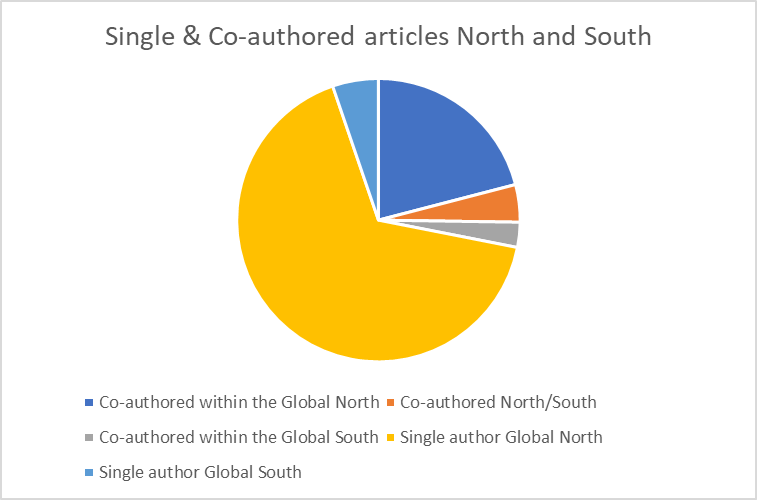
Conclusions and future directions
The RSQ is globally diverse, with contributions from authors based in institutions in 39 countries, and a wide geographic focus, with articles that examine case studies in every region of the world. Although the journal retains a strong focus on refugees and asylum seekers (79% of articles), it has also branched out to include articles on IDPs, stateless individuals and other migrants.
As in similar analyses of the Journal of Refugee Studies and Migration Studies, the analysis of ten years of articles published in RSQ indicates a disproportionate concentration of knowledge production about forced migrants far from where most forced migrants live. This discrepancy mirrors global inequities in economic, social and political spheres between the Global North and the Global South.
Although 85% of the world’s 79.5 million forced migrants reside in the Global South, almost all of the authors of articles in the RSQ over the past 10 years (89%) were affiliated to Global North institutions. This can have implications for the content of the research, with only 27% of the articles focused on forced displacement in the Global South, a figure which might change significantly if the journal had more articles by Global South authors.
Questions to consider for the RSQ board
These findings are relevant for the RSQ board, institutional subscribers, and individual researchers. The board may consider initiatives such as: offering discounted access to historical online content in addition to OUP’s discounted subscription rate for institutions in developing countries for print and current online content (just 6% of RSQ articles are Open Access); ensuring that the editorial board and reviewers which assesses articles reflect diverse perspectives, knowledges and lived experiences; and encouraging submissions for special issues proposals and paper on underrepresented regions, topics or displaced groups.
Questions to consider for the forced migration research community
Global North institutions and scholars may consider this analysis as a call to action to proactively seek co-authors in the Global South and to partner with Global South scholars in developing new research projects which offer meaningful partnerships, given the potential for inequities in scholarly partnerships. Global South institutions and scholars may consider this analysis as an encouragement to continue to submit articles to the RSQ in order to amplify their important voices in the academic discourse. The forced migration research community may also initiate a virtual convening among Global North and Global South scholars to foster networking to facilitate collaboration and knowledge sharing, as well as to discuss and reflect on how inequities may be perpetuated in scholarly partnerships and in research.
Questions to consider in future analyses of migration journals
Future analyses of journal publications may examine the content and authorship of RSQ and other journals in more detail, such as incorporating nationality of authors into the analysis to get a better picture of who is writing for the journal, or further examining the content and topics of articles.
Moving forward, further efforts can ensure that the important scholarly work of the RSQ continues to proactively and meaningfully contribute to political, social and economic movements which are seeking to address Global North-South inequities.
[1] The authors would like to acknowledge the supervision and guidance of Dr. Diana Martin and Bethan Mathias, researchers with the RECAP project at the Refugee Law Initiative.
[2] BS Chimni, ‘The Birth of a “Discipline”: From Refugee to Forced Migration Studies’ (2009) 22 Journal of Refugee Studies 11 <https://doi.org/10.1093/jrs/fen051>
[3] UNHCR, 2019 Global Trends Report < https://www.unhcr.org/figures-at-a-glance.html>
[4] ‘UNSD — Methodology’ <https://unstats.un.org/unsd/methodology/m49/> accessed 24 August 2020.
[5] See “How global is the Journal of Refugee Studies?” <https://carleton.ca/lerrn/2020/how-global-is-the-journal-of-refugee-studies/> and “Does the gap in migration research between high-income countries and the rest of the world matter?” <https://www.compas.ox.ac.uk/2019/does-the-gap-in-migration-research-between-high-income-countries-and-the-rest-of-the-world-matter/>.
[6] UN Department of Economic and Social Affairs, ‘World Population Prospects 2019’ <https://population.un.org/wpp/Publications/Files/WPP2019_DataBooklet.pdf>